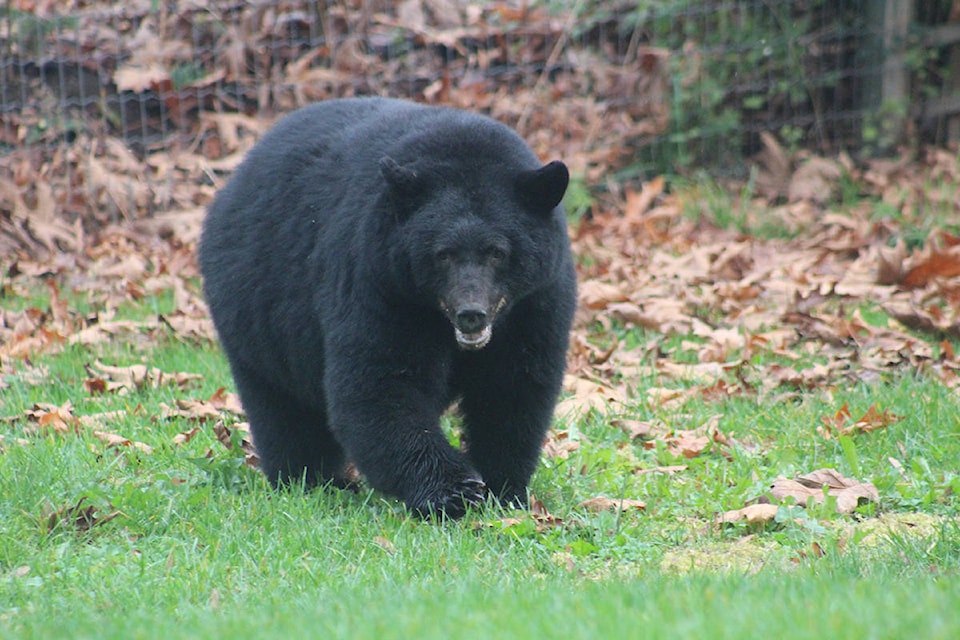There has been a significant increase in the number of black bear conflict reports in British Columbia this time compared to last year.
According to Chris Doyle, the deputy chief with B.C. Conservation Officer Services, black bear-related calls have nearly doubled this year over last year in the province. He said 8,900 black bear conflict reports have been issued to the COS since April 1, compared to 4,900 in the same time last year.
Doyle said many of the conflicts between humans and bears are preventable. Conflicts typically occur when bears become habituated to human habitats or food.
“The COS would like to remind the public to secure attractants such as garbage and fruit that might attract bears, and also, a reminder that it’s an offence under the B.C. Wildlife Act to feed or attract dangerous wildlife,” he said.
Doyle said the main reason for the dramatic increase in bear conflict reports this year is the decreased natural food supply of bears.
“This year, having experienced a colder, wet spring, it’s likely some of their natural food was delayed in ripening. That brought some of those bears into conflict [with humans],” he said.
The increase in bear/human incidents comes almost a year after the provincial government updated its policy for dealing with wild animals that come into conflict with humans. The Ministry of Environment’s policy update removed long-distance translocation of a wild animal— trapping, moving and releasing — as a preferred method of deterring them from human interaction.
Doyle said conservation officers only use translocation under certain circumstances. The COS has only translocated two black bears since April 2017, according to the department’s statistics.
“Translocation is not viewed as a successful outcome for human/wildlife conflict,” said Doyle. “In general, what we see is that the bears will return from translocation or they may not survive in the location they’re taken to. It’s something we use very seldom.”
Instead of translocation, conservation officers should use various aversion methods on wild animals to promote negative associations with humans. These include hazing, rubber bullets, electric shock and foul-tasting chemicals, among other ways.
However, if those techniques are not effective the animal can be put down, in compliance with the B.C. Wildlife Act.
“It’s not something a CO wants to do,” said Doyle, referring to bears being put down. “It’s certainly something we work hard at trying to prevent. But when a bear is destroyed it’s ultimately because a bear has become habituated to a different food condition and is a risk to public safety, causing property damage and also maybe predatory towards livestock or domestic animals.”
In the Comox Valley, a three-year old black bear was put down on July 5 after wandering through the Town of Comox and swimming in the bay. Conservation officer James Hilgemann and members of the Comox Valley RCMP followed the bear for two hours as it made its way into a residential area.
The bear was eventually killed after scampering up a tree.
The Association for the Protection of Fur-Bearing Animals is a wildlife advocacy group in B.C. Also known as the “Fur Bearers,” the association’s executive director Lesley Fox says that putting down bears should only be considered as a last resort by conservation officers. Her association recently launched a lawsuit against the province regarding B.C’s policy for handling conflict bears. The lawsuit stems from a May 2016 killing of an orphaned bear cub near Dawson Creek by a local conservation officer.
“The Fur Bearers really encourages our conservation officers to exhaust all non-lethal options first and I think that’s what the public also expects,” she said. “I was really sad to hear about the bear that was killed in Comox in July and it’s a story that’s quite common across B.C.”
Fox said there are many measures that can prevent incidents like what happened last month in Comox.
“I think the main question here is, were all non-lethal options exhausted? It’s worth finding out more of the history on that bear and what was done,” she said. “Was education provided to the community? Does the Town of Comox have appropriate garbage receptacles? Could the town have done more to prevent this incident from occurring in the first place?”
For more information on how to be “bear smart,” go to
For more information on the COS program and policies, go to



